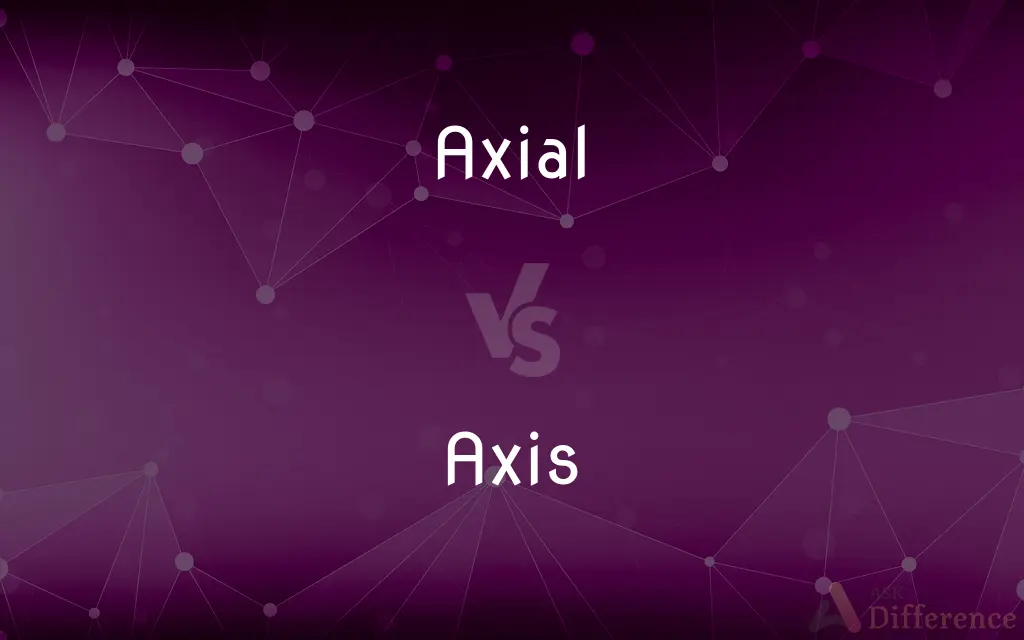Axial vs. Axis — What's the Difference?
By Urooj Arif & Fiza Rafique — Updated on April 8, 2024
Axial relates to the axis, indicating orientation or position, while axis is a central line around which something rotates or is symmetrically arranged.

Difference Between Axial and Axis
Table of Contents
ADVERTISEMENT
Key Differences
The term "axial" is used to describe anything related to or situated on an axis. It often refers to the position, direction, or components in various fields, such as anatomy, where it might denote the orientation of body parts along the central line. On the other hand, "axis" is a more concrete term, denoting the actual central line or pivot point around which objects rotate or are organized. This can be in physical, mathematical, or conceptual contexts.
In geometry and mathematics, "axial" symmetry refers to symmetry around an axis, suggesting a mirrored arrangement of components or facets across a line. Conversely, an "axis" in these fields is the line itself around which the symmetry occurs, central to understanding shapes, rotations, and reflections.
In anatomy, "axial" pertains to the body parts located along the central line of the body, such as the head, neck, and trunk. The "axis," in a more specific sense, can refer to the second cervical vertebra, pivotal for the rotation of the head, illustrating the distinction between a concept and a specific anatomical part.
When discussing machinery or technology, "axial" components are those aligned along or around an axis, essential for the function of rotating devices. The "axis" here is the shaft or spindle around which these components operate, highlighting the dependency of axial parts on a central axis for their operational context.
Despite their interconnectedness, "axial" and "axis" serve distinct purposes: "axial" modifies or describes attributes and orientations related to an axis, while "axis" identifies the central line itself, foundational in physics, geometry, and beyond.
ADVERTISEMENT
Comparison Chart
Definition
Pertaining to or located on an axis
The central line around which something rotates or is arranged
Contexts
Orientation, symmetry, anatomy
Geometry, anatomy, physics
Examples
Axial skeleton, axial load
Earth's axis, axis of rotation
Function
Describes orientation or relationship to an axis
Identifies the central line or pivot point
Importance
Indicates directionality or position relative to a central point
Serves as a foundational reference point for rotation or symmetry
Compare with Definitions
Axial
Relating to, or resembling an axis.
The axial alignment of the wheels ensures the car's stability.
Axis
The central or main part around which other parts are collected or arranged.
The main axis of the building is aligned east-west.
Axial
Pertaining to axial symmetry, where something is symmetrical around an axis.
The vase displayed axial symmetry, with patterns repeating around its center.
Axis
A reference line drawn on a graph or chart for measuring coordinates.
The horizontal axis on the graph represents time.
Axial
Denoting a type of force that passes through the centroid of a section.
The column experiences axial stress under the weight of the structure.
Axis
In anatomy, a pivot point around which parts move.
The axis vertebra allows for the rotation of the head.
Axial
Situated around, in the direction of, or on an axis.
Axial fans are designed to push air along the axis of rotation.
Axis
A straight line around which an object rotates.
The Earth rotates on its axis, causing day and night.
Axial
Involving an axis in anatomy or botany.
The axial skeleton includes the skull, spine, ribs, and sternum.
Axis
A principle or line of development.
The axis of the debate shifted towards environmental concerns.
Axial
Relating to or forming an axis
The main axial road
Axis
A straight line about which a body or geometric object rotates or may be conceived to rotate.
Axial
Relating to, characterized by, or forming an axis.
Axis
An unlimited line, half-line, or line segment serving to orient a space or a geometric object, especially a line about which the object is symmetric.
Axial
Located on, around, or in the direction of an axis.
Axis
A reference line from which distances or angles are measured in a coordinate system.
Axial
Relating to, resembling, or situated on an axis
Axis
A center line to which parts of a structure or body may be referred.
Axial
(anatomy) Belonging to the axis of the body, or to the axis of any appendage or organ
The axial skeleton
The axial bones
Axis
The second cervical vertebra on which the head turns.
Axial
(botany) In the same direction as the axis, parallel to the axis.
The secondary xylem usually consists of axial and radial elements.
Axis
Any of various central structures, such as the spinal column, or standard abstract lines used as a positional referent.
Axial
(chemistry) oriented close to the axis running through the centre of a cyclohexane ring, as opposed to equatorial. See w:Axial bond.
Axis
An imaginary line to which elements of a work of art, such as a picture, are referred for measurement or symmetry.
Axial
(ornithology) A flight feather that appears between the primaries and secondaries on some birds.
Axis
(Botany) The main stem or central part about which organs or plant parts such as branches are arranged.
Axial
(dentistry) A plane parallel to the surface of a tooth.
Axis
One of three mutually perpendicular lines that define the orientation of an aircraft, with one being along its direction of travel and the other two being perpendicular to the direction of travel.
Axial
Of or pertaining to an axis; of the nature of, or resembling, an axis; around an axis.
To take on an axial, and not an equatorial, direction.
Axis
A line through the optical center of a lens that is perpendicular to both its surfaces.
Axial
Belonging to the axis of the body; as, the axial skeleton; or to the axis of any appendage or organ; as, the axial bones.
Axis
One of three or four imaginary lines used to define the faces of a crystal and the position of its atoms.
Axial
Of or relating to or resembling an axis of rotation
Axis
An alliance of powers, such as nations, to promote mutual interests and policies.
Axial
Relating to or attached to the axis;
Axial angle
Axis
Axis The alliance of Germany and Italy in 1936, later including Japan and other nations, that opposed the Allies in World War II.
Axial
Situated on or along or in the direction of an axis
Axis
(geometry) An imaginary line around which an object spins (an axis of rotation) or is symmetrically arranged (an axis of symmetry).
The Earth rotates once a day on its axis
Axis
(mathematics) A fixed one-dimensional figure, such as a line or arc, with an origin and orientation and such that its points are in one-to-one correspondence with a set of numbers; an axis forms part of the basis of a space or is used to position and locate data in a graph (a coordinate axis)
Axis
(skeleton) The second cervical vertebra of the spine
Axis
(anatomy) An imaginary, visualized plane separating two morphologically similar parts of an organism
Axis
(psychiatry) A form of classification and descriptions of mental disorders or disabilities used in manuals such as the DSM (Diagnostic and Statistical Manual of Mental Disorders)
Axis
(botany) The main stem or central part about which organs or plant parts such as branches are arranged
Axis
(military) An alliance or coalition.
Axis
A deer native to Asia, of species Axis axis.
Axis
The spotted deer (Cervus axis or Axis maculata) of India, where it is called hog deer and parrah (Moorish name).
Axis
A straight line, real or imaginary, passing through a body, on which it revolves, or may be supposed to revolve; a line passing through a body or system around which the parts are symmetrically arranged.
Axis
A straight line with respect to which the different parts of a magnitude are symmetrically arranged; as, the axis of a cylinder, i. e., the axis of a cone, that is, the straight line joining the vertex and the center of the base; the axis of a circle, any straight line passing through the center.
Axis
The stem; the central part, or longitudinal support, on which organs or parts are arranged; the central line of any body.
Axis
The second vertebra of the neck, or vertebra dentata.
Axis
One of several imaginary lines, assumed in describing the position of the planes by which a crystal is bounded.
Axis
The primary or secondary central line of any design.
Axis
A straight line through a body or figure that satisfies certain conditions
Axis
The center around which something rotates
Axis
The main stem or central part about which plant organs or plant parts such as branches are arranged
Axis
In World War II the alliance of Germany and Italy in 1936 which later included Japan and other nations;
The Axis opposed the Allies in World War II
Axis
A group of countries in special alliance
Axis
The 2nd cervical vertebra; serves as a pivot for turning the head
Common Curiosities
What is the difference between axial and axis in geometry?
In geometry, axial refers to symmetry or orientation around an axis, while an axis is the line itself around which symmetry or rotation occurs.
How is axial used in anatomy?
In anatomy, axial pertains to structures located along the central line of the body, such as the axial skeleton.
Can the term axial be used in technology?
Yes, in technology, axial often describes components or forces aligned with or around the axis of a device, like in axial fans.
What does axial mean?
Axial refers to anything related to, situated on, or arranged around an axis.
What role does the axial skeleton play in the human body?
The axial skeleton provides support and protection for the brain, spinal cord, and vital organs within the chest and abdomen.
What is the significance of an axis in the Earth's rotation?
The Earth's axis is crucial for the planet's rotation, resulting in the cycle of day and night as well as seasonal variations.
What is an axis?
An axis is a central line around which something rotates or is symmetrically arranged.
Is axial symmetry the same as radial symmetry?
No, axial symmetry involves symmetry around a central axis, while radial symmetry means symmetry around a central point in all directions.
How does the concept of an axis apply in mathematics?
In mathematics, an axis often refers to a reference line used in graphs and geometry to measure coordinates or define rotations.
How are axial loads different from radial loads?
Axial loads are directed along the axis of an object, while radial loads are directed perpendicular to the axis.
What does it mean when something is described as axial in botany?
In botany, axial may refer to structures or growth patterns that occur along the main stem or axis of a plant.
Can the term axis refer to something abstract?
Yes, in abstract uses, an axis can refer to a principal line of direction, development, or thought.
Share Your Discovery

Previous Comparison
Stripe vs. Strip
Next Comparison
Alcoholic vs. LushAuthor Spotlight
Written by
Urooj ArifUrooj is a skilled content writer at Ask Difference, known for her exceptional ability to simplify complex topics into engaging and informative content. With a passion for research and a flair for clear, concise writing, she consistently delivers articles that resonate with our diverse audience.
Co-written by
Fiza RafiqueFiza Rafique is a skilled content writer at AskDifference.com, where she meticulously refines and enhances written pieces. Drawing from her vast editorial expertise, Fiza ensures clarity, accuracy, and precision in every article. Passionate about language, she continually seeks to elevate the quality of content for readers worldwide.
















































